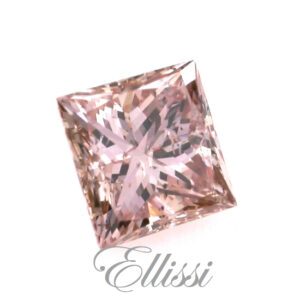Pink Diamonds are Graded for Their Colour Saturation and Hue.
Pink diamonds are highly prized and very costly. They are also very rare compared to their white cousins. When grading coloured diamonds, the Gemological Institute of America (GIA) break the grade into two components parts. The “fancy grade” and then also “colour description”. The fancy grade assesses the tone and saturation of the colour of the diamond face up, so it assesses the strength of the colour. The “colour description” looks at the hue range. The combination of the two describes the colour of the diamond.
The most costly and strongest colour of the fancy grades is Fancy Vivid. Other grade levels include Fancy Deep, Fancy Intense, Fancy, Fancy Light, and Light pink. These are roughly in line with the GIA scale on Fancy Yellow diamonds etc.
Due to the very high degree of value attached to Pink Diamonds, many varied colour shade terms are also needed. You may see the GIA use descriptions like “Fancy intense purple brownish pink” among others. Being exact in describing colours is to some extent is not possible due to the individual nature of gems.
Super Rare Red Diamonds.
Red diamonds are graded separately to pink diamonds. The darkest colour in the pink hue range is red but red is not actually on the pink scale. It is the deep tone and saturation of colour that gives us extremely, extremely rare red diamonds. These are graded as “Fancy Red”.
There is not the same variation in grading terminology for red diamonds as there is for pink diamonds. This is because diamonds that appear to be red do not have the same range of colour depth, tone or saturation as pink diamonds do.
Very few people in the world will ever see a red diamond, and fewer still could ever even dream of owning one, it is the province of the richest of the rich.
Australia’s Argyle Mine.
The Argyle mine here in Australia is the world’s largest producer of pink diamonds. The supply of pink diamonds at the mine is becoming limited with supply running out when the mine becomes unviable, assumed to be around 2025, possibly so

oner. Due to their rarity, the best of Argyle’s pink diamonds are bought by the trade annually as part of a worldwide tender.
Only around 100 people involved in the jewellery trade can view the diamonds and participate in the tender process. Diamonds that are under 0.50ct. that are not of the best hue and intensity are not part of the tender. These are available for the rest of the trade to buy outside the tender process.
Argyle have their own grading scale system for pink diamond colour. This uses alpha numerical terminology for various shades of pink. This system is more in use in the jewellery trade generally for costing and reference.
The Argyle scale has 27 levels from #1 Purple Pink ( 1PP ) to Pink Champagne ( PC 1-3 ) to brownish pink ( 1BP ). The Argyle scale is easier to follow than the GIA system. Although it must be said the GIA’s colour description rather than a scale is more useful in a way. This is because it is more flexible and better suited to the massive variation in colour that is seen when documenting individual diamonds.
Colour Treated Diamonds.
Due to the enormous cost of natural pink diamonds, diamond companies around the world have developed methods to colour treat diamonds. This is to try to cater for the demand in pink diamonds at a reduced cost.
Treatments include irradiation and annealing and coating methods. Pink diamonds can be grown in laboratories. GIA grading reports distinguish between natural diamonds and those that have been treated or lab grown. The GIA discloses any treatments in their reports. This is very important as coating treatments are not permanent, and will eventually become patchy.
Click on the following link for more information about Coloured Diamonds
